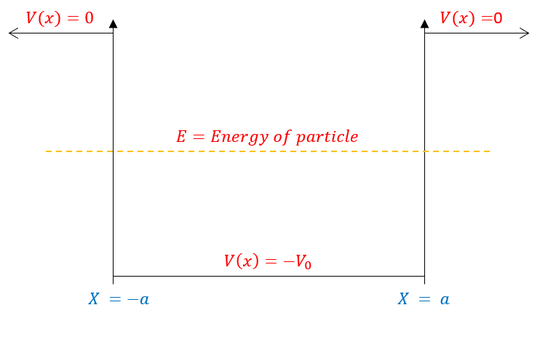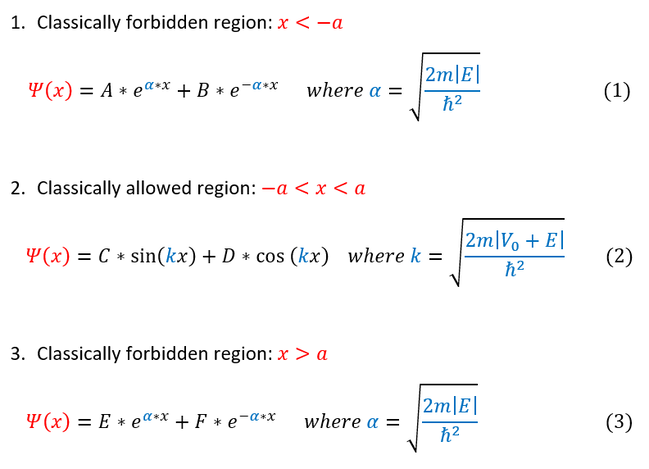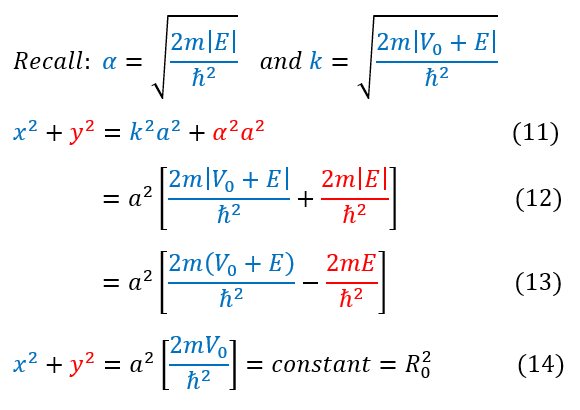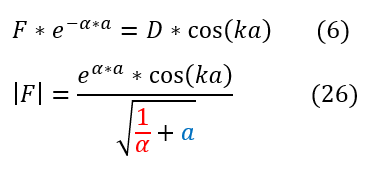Mind Network - Samuel Solomon
Bound States
Patching Solutions Together
While we have solved the bound state
problem qualitatively, to grasp the material we need to actually solve a
problem. To do this, we need to plug in a potential. We will define the problem
below:
To tackle this problem, let us divide the graph into 3 different regions:
In order to make sure everyone is following: we have previously solved for equations 1, 2, and 3. All that is different is that instead of the general ‘|V – C|’ expression, we plugged in our specific problem’s values.
We can now add in the constraint that the end regions must decay to the x axis (the whole function must have a finite area and be normalizable). This boundary condition can be accounted for in regions I and III below:
We can now add in the constraint that the end regions must decay to the x axis (the whole function must have a finite area and be normalizable). This boundary condition can be accounted for in regions I and III below:
The last fact to notice is that the potential for this specific bound state is even. Hence, the parity relation V(x) = V(-x) holds. As discussed previously, for even potentials the wave function is only composed of even and odd basis states, and hence the wave function here is either even or odd. As we are just running through an example, let us focus solely on the even solution; however, finding the odd solution would follow similar steps.
Even functions follow the following form: psi(x) = psi(-x). Hence: A = F and all odd functions (like sin(kx)) drop out (C = 0). The wave function can now be represented as so:
Even functions follow the following form: psi(x) = psi(-x). Hence: A = F and all odd functions (like sin(kx)) drop out (C = 0). The wave function can now be represented as so:
Now it is time to patch together these three regions. As previously discussed, a wave function and its first derivative must always be continuous. We now apply these boundary conditions below:
Diving equation 7 by equation 6 yields the follow get:
In this equation we can notice that not all 'k' and 'α' expressions are possible. They follow a close relationship. We can see which certain values of 'k' and 'α' are allowed pictorially by setting x = 'ka' and y = 'αa.' This reduces the equation below:
We call equation 10 one of the transcendental equations. The second transcendental equation is found below:
In order to make sure everyone is following, let us review some key steps below:
11: We start by calculating x^2 + y^2, where x = 'ka' and y = 'αa'
11 to 12: We substitute in our definitions for 'k' and 'α'
12 to 13: 'V_0' is a positive number and 'E' is a negative number. 'V_0 - E' as well as '- E' are both positive quantities (we
use this to get rid of the absolute value.
13 to 14: Simplify the expression. Notice that x^2 + y^2 is a constant we will call R_0^2
One might immediately recognize why we call the constant R_0^2. x^2 + y^2 describe a 2 dimensional circle with radius R_0, where the radius only depends on the constant V_0 that we set. We can now simultaneously graph these two transcendental equations together.
We can now appreciate the thought process going into finding these two equations. The first equation was just a constraint on x and y that has to be satisfied for our function to normalize. The second equation was the constraint on x and y based on the potential V_0 we set in the problem. Where they intersect are the actual x and y solutions to the problem. x and y are a function of energy and hence if x and y have a continuous spectrum of allowed values, so does energy; however, when we graph these equations we obtain:
11: We start by calculating x^2 + y^2, where x = 'ka' and y = 'αa'
11 to 12: We substitute in our definitions for 'k' and 'α'
12 to 13: 'V_0' is a positive number and 'E' is a negative number. 'V_0 - E' as well as '- E' are both positive quantities (we
use this to get rid of the absolute value.
13 to 14: Simplify the expression. Notice that x^2 + y^2 is a constant we will call R_0^2
One might immediately recognize why we call the constant R_0^2. x^2 + y^2 describe a 2 dimensional circle with radius R_0, where the radius only depends on the constant V_0 that we set. We can now simultaneously graph these two transcendental equations together.
We can now appreciate the thought process going into finding these two equations. The first equation was just a constraint on x and y that has to be satisfied for our function to normalize. The second equation was the constraint on x and y based on the potential V_0 we set in the problem. Where they intersect are the actual x and y solutions to the problem. x and y are a function of energy and hence if x and y have a continuous spectrum of allowed values, so does energy; however, when we graph these equations we obtain:
From For different V_0 potentials, we have different, yet specific, x and y values possible. Because x and y are functions of the particle's energy, we therefore have specific possible energy states for the particle. Energy is not a continuous spectrum but rather quantized yet again.
Note, in my picture above: purple dots represent the overlap between the two transcendental equations. I graphed the even solutions we found to the right, but additionally showed the odd states as well in the left picture in case anyone tried to solve that set.
Let us analyze a few very important points about the graph:
1. There always exists at least 1 bound even state (unless V_0 = 0 which would mean that there is no well)
2. There are R_0/pi even bound states (rounded down to an integer value)
3. There are discrete x , y values that work and hence discrete k , α values that exist
4. x can never be greater than R_0
We can additionally do a self check that the bound state solution will trend towards the infinite square well solution as V_0 goes to infinity. When V_0 goes to infinity, R_0 also goes towards infinity and the circle essentially becomes a straight line (shown in the picture above). The x intersections points are therefore:
Note, in my picture above: purple dots represent the overlap between the two transcendental equations. I graphed the even solutions we found to the right, but additionally showed the odd states as well in the left picture in case anyone tried to solve that set.
Let us analyze a few very important points about the graph:
1. There always exists at least 1 bound even state (unless V_0 = 0 which would mean that there is no well)
2. There are R_0/pi even bound states (rounded down to an integer value)
3. There are discrete x , y values that work and hence discrete k , α values that exist
4. x can never be greater than R_0
We can additionally do a self check that the bound state solution will trend towards the infinite square well solution as V_0 goes to infinity. When V_0 goes to infinity, R_0 also goes towards infinity and the circle essentially becomes a straight line (shown in the picture above). The x intersections points are therefore:
One can go back and verify that this is indeed the 'k' value we found for the infinite square well.
The last bit of this problem will just solve for the general coefficients for 'D' and 'F.' All one has to do is normalize the wave function and set the integral to 1. The math for this normalization can be found below (it is always good practice):
The last bit of this problem will just solve for the general coefficients for 'D' and 'F.' All one has to do is normalize the wave function and set the integral to 1. The math for this normalization can be found below (it is always good practice):
In order to make sure everyone is following, let us review some key steps below:
16: The definition of normalization (need to integrate over the whole region, all three)
16 to 17: Take the integral (these are common integrals, but one can plug them into wolfram to check)
17 to 18: Plug in the bounds of each integral
18 to 19: e^-infinity is essentially zero
We will now use equation 7 to substitute out 'F' from the expression:
16: The definition of normalization (need to integrate over the whole region, all three)
16 to 17: Take the integral (these are common integrals, but one can plug them into wolfram to check)
17 to 18: Plug in the bounds of each integral
18 to 19: e^-infinity is essentially zero
We will now use equation 7 to substitute out 'F' from the expression:
In order to make sure everyone is following, let us review some key steps below:
20: Substitute equation 7 into equation 19
20 to 21: Use the first transcendental equation (equation 9) to replace 'k'
21 to 22: Simplify the expression
22 to 23: Expand sin(2ka) using the trigonometric identity
23 to 24: Simplify the expression
24 to 25: Use the trigonometric identity sin^2 + cos^2 = 1 to simplify the expression
We have now solved for the coefficient 'D' for the EVEN solutions. Using equation 6 (constraint that the wave function must be continuous), we can solve for the last efficient 'F' below:
20: Substitute equation 7 into equation 19
20 to 21: Use the first transcendental equation (equation 9) to replace 'k'
21 to 22: Simplify the expression
22 to 23: Expand sin(2ka) using the trigonometric identity
23 to 24: Simplify the expression
24 to 25: Use the trigonometric identity sin^2 + cos^2 = 1 to simplify the expression
We have now solved for the coefficient 'D' for the EVEN solutions. Using equation 6 (constraint that the wave function must be continuous), we can solve for the last efficient 'F' below:
|
|
|














